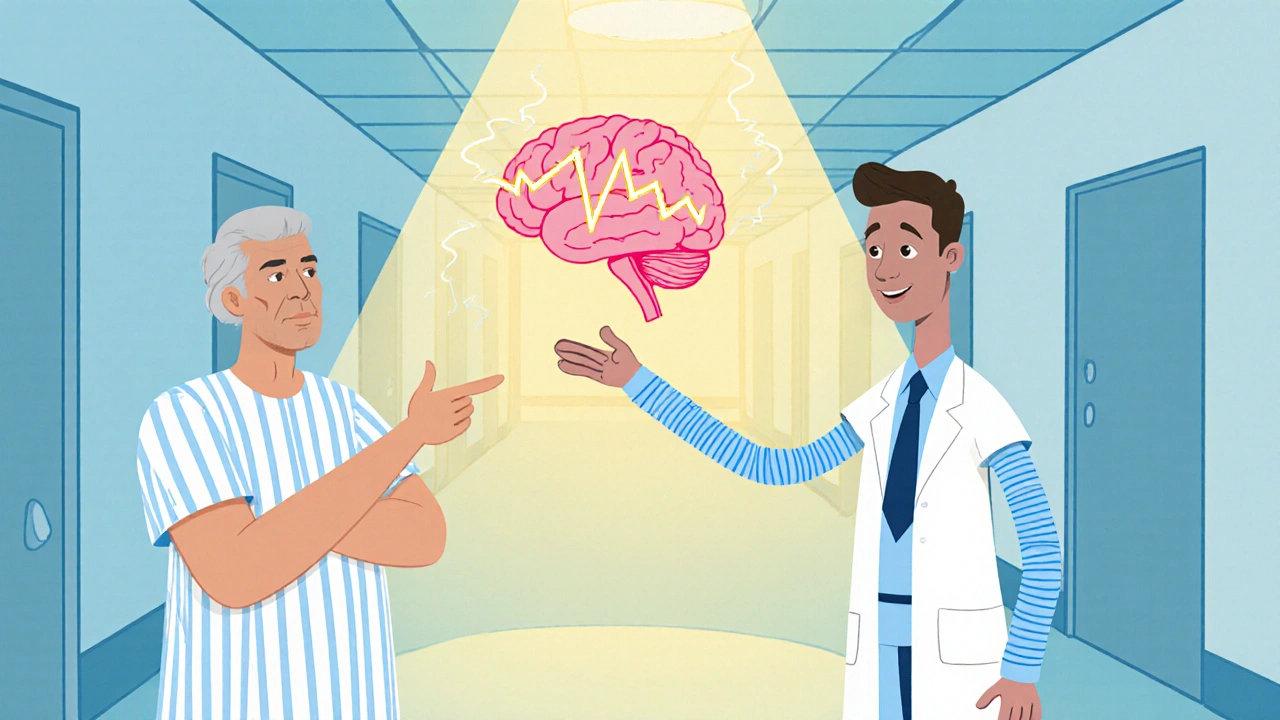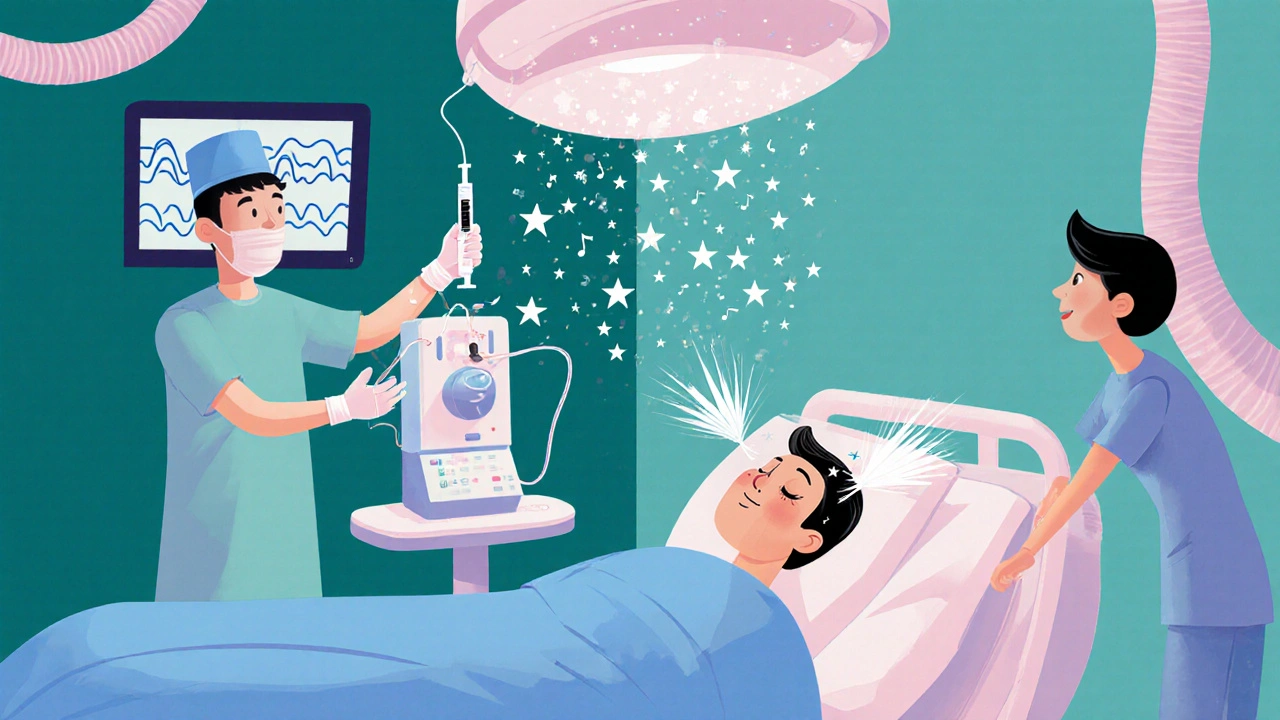
ECT Treatment Comparison Tool
Compare Depression Treatment Options
Select a treatment to see how it compares to the others in terms of effectiveness, side effects, and treatment duration.
Days to weeks
70-80%
6-12 sessions (2-3 per week)
Short-term memory gaps, retrograde amnesia, headache, muscle soreness. Severe complications are rare with modern protocols.
When medication and talk therapy stop delivering relief, many patients wonder if there’s a fast‑acting option that actually works. Electroconvulsive Therapy is a medically supervised procedure that induces a brief, controlled seizure to reset brain activity. It’s been used for decades, yet misconceptions keep it out of the conversation. This guide walks through how ECT works for Major Depressive Disorder, who benefits most, the real side‑effects, and how it stacks up against newer modalities.
What Is Electroconvulsive Therapy?
In plain terms, ECT delivers a short electric pulse to the brain while the patient is under general anesthesia. The pulse triggers a brief seizure-typically lasting less than a minute-followed by a rapid recovery. The exact mechanism isn’t fully mapped, but research points to a surge of neurochemicals (like serotonin, dopamine, and norepinephrine) and enhanced neuroplasticity that help lift depressive symptoms.
Why Consider ECT for Major Depressive Disorder?
Major Depressive Disorder (MDD) is not just feeling sad; it’s a chronic, disabling condition that can impair daily functioning, increase suicide risk, and resist standard treatments. The American Psychiatric Association (APA) recommends ECT when:
- Depression is severe or life‑threatening, especially with suicidal thoughts.
- Patients have not responded to at least two adequate trials of antidepressants.
- Rapid symptom relief is essential-e.g., during pregnancy or in elderly patients where medication side‑effects are risky.
Studies published in the Journal of Clinical Psychiatry (2023) show remission rates of 70‑80% for treatment‑resistant MDD, far higher than typical medication response (~30%).
How the Procedure Is Done
The process involves several steps, each performed by a multidisciplinary team:
- Pre‑assessment: A psychiatrist evaluates the diagnosis, medical history, and conducts a baseline Hamilton Depression Rating Scale (HDRS) score.
- Fasting & consent: Patients fast for 6‑8 hours, sign an informed consent form, and discuss potential memory changes.
- Anesthesia & muscle relaxant: An anesthesiologist administers a short‑acting agent (usually methohexital) and a muscle relaxant (succinylcholine) to prevent injury during the seizure.
- Electrode placement: Electrodes are positioned either bilaterally (both sides of the head) for stronger effect or unilaterally (one side) to reduce cognitive side‑effects.
- Electric stimulus: A controlled electric current (0.5-1.0 coulombs) is delivered, triggering a seizure lasting 30‑45 seconds, monitored via EEG.
- Recovery: Patients awaken within minutes, often feeling groggy but otherwise stable. Monitoring continues for 30‑60 minutes before discharge.
Typical courses involve 6‑12 sessions, administered two to three times per week. Some patients achieve remission after the first few treatments, while others need the full series.
Benefits of ECT for Depression
Why do clinicians still rely on a treatment that originated in the 1930s? The answers are concrete:
- Speed: Significant symptom reduction can appear after 1‑2 sessions, crucial for suicidal patients.
- Effectiveness: Meta‑analyses report remission in 70‑80% of severe, treatment‑resistant cases.
- Safety profile: Modern ECT uses brief pulses, muscle relaxants, and careful monitoring, keeping mortality below 0.01% (comparable to routine anesthesia).
- Versatility: Safe for pregnant women, the elderly, and patients with severe medical comorbidities.
Risks and Common Side‑Effects
No medical intervention is without downsides. The most frequently discussed concern is memory loss:
- Short‑term memory gaps: Patients may forget events occurring in the days surrounding treatment. This usually resolves within weeks.
- Retrograde amnesia: Older, bilateral ECT can affect older memories, though most people retain core autobiographical facts.
- Physical side‑effects: Headache, muscle soreness, nausea, or mild confusion lasting a few hours.
Severe complications-like prolonged seizures, cardiovascular events, or permanent cognitive deficits-are exceedingly rare with contemporary protocols.

Comparing ECT to Other Depression Treatments
To help decide if ECT fits, here’s a quick snapshot against two common alternatives: Pharmacotherapy (SSRIs/SNRIs) and Transcranial Magnetic Stimulation (TMS).
| Factor | Electroconvulsive Therapy | Antidepressant Medication | Transcranial Magnetic Stimulation |
|---|---|---|---|
| Onset of Effect | Days to weeks | 4‑6 weeks | 2‑4 weeks |
| Remission Rate (severe MDD) | 70‑80% | 30‑40% | 45‑55% |
| Typical Course Length | 6‑12 sessions (2‑3 per week) | Months to years | 30‑36 sessions (5 per week) |
| Major Side‑Effects | Memory loss, anesthesia risks | Weight gain, sexual dysfunction, GI upset | Scalp discomfort, rare seizure (<0.1%) |
| Eligibility | Broad (including pregnant, elderly) | Requires liver/kidney clearance | Excludes patients with metal implants or seizure disorders |
This table shows why ECT remains the go‑to when speed and high remission matter most.
Addressing Common Myths
Myth #1: "ECT is a painful shock." Modern ECT uses anesthesia and muscle relaxants, so patients feel no pain.
Myth #2: "It’s a barbaric, outdated practice." The APA’s 2022 guidelines endorse ECT as a first‑line option for certain severe cases.
Myth #3: "Memory loss is permanent." Most memory issues are short‑term; long‑term retrograde amnesia is rare and usually limited to older, less‑targeted memories.
Aftercare and Long‑Term Outlook
After the final session, clinicians typically outline a maintenance plan:
- Medication: Continuing an antidepressant can sustain gains.
- Therapy: Cognitive‑behavioral therapy (CBT) helps embed coping skills.
- Maintenance ECT: For patients with recurrent depression, a spaced‑out schedule (e.g., monthly) can prevent relapse.
Long‑term studies (Harvard Medical School, 2024) indicate that patients who receive maintenance ECT plus psychotherapy have a 50% lower relapse rate over two years compared to medication alone.
Choosing the Right Provider
Not all hospitals offer the same quality of ECT. Look for facilities that:
- Employ board‑certified psychiatrists with APA‑endorsed ECT training.
- Use modern, brief‑pulse equipment and unilateral electrode placement when possible.
- Provide comprehensive pre‑ and post‑treatment counseling.
Ask about their success rates, average number of sessions needed, and how they monitor cognitive function.
Quick Takeaways
- Electroconvulsive therapy offers the fastest relief for severe, treatment‑resistant depression.
- Remission rates hover around 75%, outpacing most meds and TMS.
- Memory loss is usually short‑term; permanent issues are rare.
- Modern ECT is safe, performed under anesthesia, and suitable for many vulnerable groups.
- Choosing an experienced center and planning maintenance care are key to lasting improvement.
Is ECT painful?
No. Patients are under general anesthesia and receive a muscle relaxant, so they feel no pain during the seizure.
How long does each ECT session last?
The entire procedure, from induction to recovery, typically takes 15‑20 minutes. The electric stimulus itself lasts a few seconds.
Can pregnant women receive ECT?
Yes. Because ECT avoids drug exposure to the fetus, it is often recommended when severe depression threatens maternal health.
What is the typical success rate for ECT?
Modern studies report remission in roughly 70‑80% of patients with severe, treatment‑resistant Major Depressive Disorder.
How does ECT compare to TMS?
ECT works faster and has higher remission rates, especially for severe cases. TMS is less invasive but requires many more sessions and has a slower onset.

 Health and Wellness
Health and Wellness
Andrew Hernandez
October 20, 2025 AT 18:14ECT can be life‑saving for those who have not responded to meds. The quick relief is impressive. It is performed under strict medical supervision. Patients should discuss memory concerns with their doctor. Overall the risk is low when done modernly.
Alex Pegg
October 22, 2025 AT 13:05I find the glorification of ECT unnecessary when alternative therapies exist. The US should focus on prevention rather than invasive shock treatments. Plus the history of abuse raises valid doubts.
laura wood
October 24, 2025 AT 05:10Reading this guide helped me understand why some families consider ECT. The balanced view of benefits and risks is much needed. It’s reassuring to know there are safeguards in place for memory issues.
Kate McKay
October 25, 2025 AT 21:15When someone battles severe depression for years, the prospect of a fast‑acting solution can feel like a beacon of hope. ECT, despite its controversial image, has decades of data supporting its efficacy. Studies show remission rates climbing into the seventies, a stark contrast to the modest outcomes of many medications. The procedure is carefully managed, with anesthesia and muscle relaxants ensuring safety. Patients typically undergo a series of sessions, usually six to twelve, and many report feeling brighter after just a few treatments. One of the biggest advantages is the rapid onset of symptom relief, which can be life‑saving for those with suicidal ideation. Of course, memory side‑effects are a legitimate concern, but most short‑term gaps resolve within weeks. Older adults, who often struggle with medication side‑effects, can benefit especially from the controlled nature of ECT. Pregnant patients also have an option that avoids exposing the fetus to drug teratogenic risks. Clinicians customize electrode placement-bilateral for stronger impact or unilateral to reduce cognitive impact. The decision should always involve a thorough discussion between patient, family, and the treatment team. Insurance coverage has improved, making the therapy more accessible than it once was. If you’re feeling stuck, asking your psychiatrist about a referral to an ECT program might be worth the conversation. Remember that every treatment has trade‑offs, and personal values play a role in choosing the right path. Support groups of former ECT patients can provide real‑world insight beyond clinical statistics. Ultimately, staying informed empowers you to make the best decision for your mental health journey.
JessicaAnn Sutton
October 27, 2025 AT 12:19While the article presents data accurately, it neglects the ethical dimensions of inducing seizures. A thorough moral analysis would consider patient autonomy. The language used could be more rigorous. Moreover, the omission of long‑term cognitive studies is a notable gap. The comparison table lacks statistical confidence intervals. Readers deserve a nuanced discussion of risk‑benefit ratios.
Israel Emory
October 29, 2025 AT 04:24I appreciate the comprehensive overview, however, we must also recognize, that patient selection, is crucial, and that clinicians, should balance, efficacy, with potential, cognitive side‑effects,! The discussion, could benefit, from more, real‑world case examples,!
Sebastian Green
October 30, 2025 AT 20:29I’ve seen ECT work where nothing else helped.
Wesley Humble
November 1, 2025 AT 12:34The presented remission rates, while impressive, omit the variance across age groups and comorbidities. Moreover, the claim of \"rapid symptom relief\" should be qualified, as transient improvements do not guarantee sustained remission. The literature cited, including the 2023 Journal of Clinical Psychiatry study, does not address the incidence of persistent retrograde amnesia in bilateral protocols. Clinicians must weigh these factors carefully before recommending ECT as a first‑line option. 📊🙂